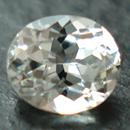|
|
|
|
Click on a letter above to view the list of gems. |
|
|
|
|
|
Forsterite |
|
| Chemistry: Mg2(SiO4) [Magnesium Silicate] | |
| Discovered
in 1824;
IMA
status: Valid (pre-IMA; Grandfathered). | ||
|
| ||
|
Classification |
|
|
| |
|
Silicates | |
|
8/A.04-10 | |
|
|
9 : SILICATES (Germanates) |
|
Related to: |
Olivine Group. Fayalite-Forsterite Series and the Forsterite-Tephroite Series. The magnesium analogue of Fayalite, Tephroite and Calcio-Olivine. A polymorph of Ringwoodite and Wadsleyite |
|
|
|
|
Crystal Data |
|
|
|
|
|
As euhedral or subhedral crystals, typically thick, with striations, with wedge-shaped terminations, to 17 cm. Commonly granular or compact massive. |
|
|
On [100], [011], [012] |
|
|
|
|
|
Physical Properties |
|
|
|
|
|
[010] Perfect; [100] Imperfect |
|
|
Conchoidal |
|
|
Brittle |
|
|
7.0 |
|
|
3.275 (g/cm3) |
|
|
None |
|
|
Not Radioacitve |
|
|
|
|
|
Optical Properties |
|
|
|
|
|
Colorless, Green, pale Yellow, White |
|
|
Transparent, Translucent |
|
|
Vitreous |
|
|
1.635 - 1.670 Biaxial ( + ) |
|
|
0.0330 - 0.0420 |
|
|
r > v or r < v |
|
|
Weak; X = colorless, Y = colorless, Z = colorless |
|
|
|
|
|
Occurances |
|
|
|
|
|
Geological Setting: |
In mafic and ultramafic igneous rocks and thermally metamorphosed impure dolomitic limestones. |
|
Common Associations: |
Amphiboles, Antigorite, Augite, Brucite, Calcite, Chromite, Corundum, Diopside, Dolomite, Enstatite, Magnetite, Phlogopite, Plagioclase, Spinel |
|
Type Locality: |
Monte Somma, Somma-Vesuvius Complex, Naples Province, Campania, Italy |
|
Year Discovered: |
1824 |
|
View mineral photos: | |
|
|
|
|
More Information |
|
|
|
|
|
| |
|
|
|
|
The gem variety of Forsterite is usually known as the bright green Peridot. But a recent find of colorless Forsterite in Mogok, Myanmar (Burma) has seemingly brought a new variety of gemstone to the market. Colorless Forsterite gems were virtually unheard of prior to this find. Forsterite is also found in many iron-nickel meteorites as large crystals. Thinly cut and polished slices of these meteorites are extremely attractive with the bright steel gray of the iron contrasted by the gemmy green Forsterite crystals. There
are many locations to find green Forsterite but the
main location for colorless Forsterite is in the Mogok
district and at Pyaung Gaung, Myanmar (Burma). |
|
|
We
have not photographed the Forsterite
gems. Please
check back soon. |
